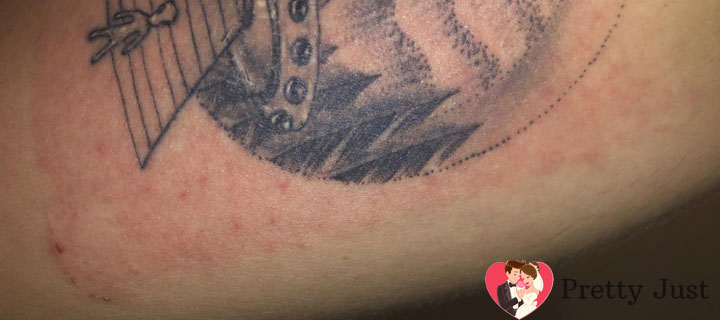Tattoo rash can develop due to allergic reactions to tattoo ink, skin sensitivity, or infections. Symptoms typically include redness, itching, and sometimes bumps or hives around the tattooed area. Managing tattoo rash involves gentle cleansing, applying topical treatments like corticosteroid creams, using cool compresses, and avoiding potential irritants.
Seek medical attention if the rash is severe, shows signs of infection, or persists despite home care efforts.
| Aspect | Description |
|---|---|
| Causes | – Allergic Reaction: An allergic reaction to tattoo ink, usually due to specific pigments or additives, can cause a rash. |
| – Skin Sensitivity: Individuals with sensitive skin may develop a rash as a reaction to tattooing or aftercare products. | |
| – Infection: Bacterial or fungal infections from improper aftercare practices can also lead to rash formation around the tattoo. | |
| Symptoms | – Redness and Itching: The affected area may appear red and feel itchy or irritated. |
| – Bumps or Hives: Small bumps or raised areas on the skin, resembling hives, may develop. | |
| – Pain or Discomfort: The rash may cause pain or discomfort, especially if it becomes inflamed or swollen. | |
| Management | – Gentle Cleansing: Clean the tattooed area with mild soap and water to remove any irritants or allergens. |
| – Topical Treatments: Apply a prescribed or over-the-counter corticosteroid cream to reduce inflammation and itching. | |
| – Cool Compress: Use a cool compress or cold pack wrapped in a cloth to soothe the affected area and alleviate discomfort. | |
| – Avoid Irritants: Avoid using perfumed lotions, harsh soaps, or other potential irritants on the tattooed skin. | |
| When to Seek Help | – Severe Symptoms: If the rash is widespread, accompanied by severe itching, swelling, or pain, seek medical attention promptly. |
| – Signs of Infection: Watch for signs such as pus, increased redness, warmth, or fever, which may indicate an infection requiring medical treatment. | |
| – Persistent Rash: If the rash persists or worsens despite home care remedies, consult with a dermatologist or healthcare provider for further evaluation. |
How To Determine You Have An Allergic Reaction?
Usually, an allergy is immediately noticeable. Itching, rash, redness, irritation accompanies an allergy. You may notice flaking of the skin, swelling, “scratching” around the tattoo. It is also a symptom of an allergy.
Your task is to ensure the allergy is not deep. Allergies to the upper layers of the skin can go away in a few days.
Problems begin when allergies affect the deeper layers of the skin. Such a serious allergy can cause a serious reaction in your body.
What Symptoms Tell You To Go To The Doctor Right Now?

Firstly, the appearance of the tattoo will be terrible. Also, there may be severe itching and hurting around the tattoo, pus may leak from the tattoo, and hard tissue may form on the tattoo.
Chills and fever, swelling around the eyes, will accompany the terrifying appearance of the tattoo. You better not wait for such a condition and go to the doctor as soon as possible.
Or Maybe It Is An Infection?
There is a possibility you have an infection. The symptoms of allergies and infections are very similar. You can take it apart.
An allergy has the following symptoms:
- All symptoms affect the skin near the tattoos.
- Itching, burning, swelling, and redness occurs in the area of the skin with a tattoo.
- If an allergy is due to ink, symptoms will be around the pigment. Red ink is the strongest allergen of all pigments.
- Allergy symptoms last several days or several weeks, and disappear if you try to cure it.
The infection has the following symptoms:
- Symptoms of infection appear everywhere, outside a tattoo.
- The main symptoms of infection are redness, irritation, itching. You will find these symptoms in any part of the body.
- Localized symptoms may occur with exposure to the entire body.
- Symptoms of infection last a very long time. It may be more than a few weeks.
What Are The Types Of Allergic Reactions?
If you find allergy symptoms, rejoice early. Allergies come in many forms. You do not need to relax because allergies can be caused by a reaction of the immune system, skin condition, ink, and so on.
There are several types of allergies:
Acute Inflammatory Allergy
This type of allergy does not occur due to ink or another allergen. This allergy is due to skin irritation when you got a tattoo.
Acute inflammatory allergy is the mildest and happens to almost everyone after getting a tattoo. Allergy symptoms go away after a while.
Photosensitivity
This treatment is due to the ink. Ink components respond to sunlight and light from a lamp. Swelling, redness, or itching occur as a result of this reaction. Photosensitivity appears due to the ink of red, yellow, black and blue colors.
Dermatitis
An allergic reaction caused by ink is contact dermatitis. This type of allergy is accompanied by swelling itching and peeling of the skin.
Granulomas
Granulomas appear due to some of the ink ingredients.It can be mercury salts, iron oxides, cobalt chloride and manganese. Again the trigger is red ink.
Lichenoid Allergy
The appearance of discolored irregularities around the ink characterizes the treatment of this type. The reason is usually red ink.
Lichenoid allergy does not cause irritation and itching in the tattoo area. These symptoms may occur in other parts of the body.
Pseudolymphomatous Allergy
This treatment does not appear immediately, but after you get a tattoo. Most of the time, the cause of this allergy is red ink.
A few months after you get a tattoo there may be a rash, redness and other irritations. Such a delay indicates that this is a pseudolymphomatous allergy.
What Is An Allergy Trigger?
At first glance, it may seem that red ink is the main cause of any allergy. It is not true.
Most often, ink components cause allergies. It can be pigments, dyes, and metallic substances.
Red ink is the most common trigger for allergies. But if a tattoo artist did not use red ink when tattooing, it does not mean that you will not get allergies.
Many inks contain dyes that are identical to those found in automotive or commercial ink. The skin is a more sensitive material than paper or metal, so a reaction will necessarily occur in such cases.
Immunity responds to the use of “unusual” components. The body tries to remove ink, so it manifests an allergy.
Why does ink contain all sorts of rubbish? FDA does not regulate ink production. Therefore, manufacturers do what they want and do not give you accurate information about the compound of the ink.
The FDA tries to keep the situation under control and keeps track of negative reviews of individual inks and its components.
You can avoid getting ink with bad ingredients. Ask the tattoo artist to find components in ink that can cause allergies or what are harmful.
Which Components Are Harmful?
Avoid any ink that contains aluminum, aminoazobenzene, cesalpinium, cadmium sulfide, carbon, chromium oxide, cobalt aluminate, cobalt chloride, iron hydride, and iron oxide.
Lead chromate, manganese, mercury sulfite, phthalocyanine dyes, sandalwood, titanium oxide, and zinc oxide are also harmful components.
What to do if you received treatment before you learned about the harmful ingredients?
When Should You See A Doctor?
The best time to see a doctor (or at least a tattoo artist) is when you notice the first swelling, pus and other symptoms of irritation.
Be sure to ask the tattoo artist about the ink they used when making the tattoo. Do this before you go to the doctor. Such information can help your doctor determine what caused the allergy.
Do not hide that you received a tattoo and any information that you received from a tattoo artist. Tell your doctor the truth and show allergies.
Can You Cure This?
Fortunately, modern medicine is not so hopeless and can eliminate allergies.
Doctors usually advise using medicines to get rid of not strong symptoms and get relief.
Some ointments soothe inflammation like hydrocortisone or triamcinolone. Antihistamines may also help reduce general symptoms.
What if you used everything but nothing helped? Doctors prescribe strong antihistamines when all else fails.
Important: be in contact with your doctor if you want to get rid of allergies.
Conclusion
Do not panic if you received treatment with a tattoo. You do not have to remove the tattoo. Go to the doctor right away, so your tattoo can stay free of scars.
And be aware of what is inside the ink the next time you get a tattoo.


